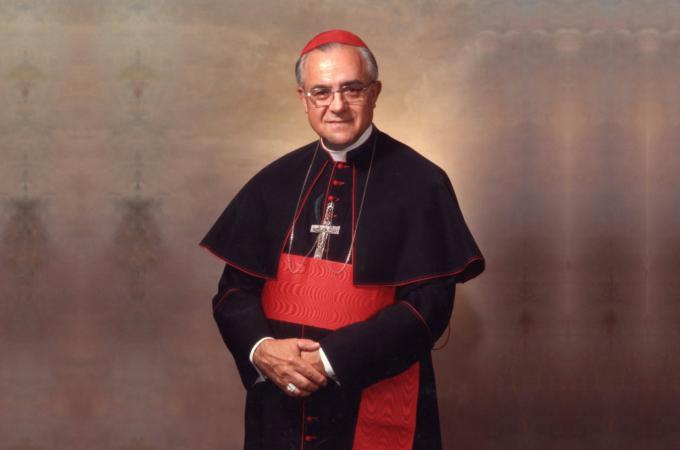Humberto Cardinal Medeiros: Youth and Education 1915-1946
On Oct. 7, 1970, Humberto Sousa Medeiros, until then the second bishop of Brownsville, was installed as the seventh bishop and the fourth metropolitan archbishop of Boston. Father Richard E. Gribble, CSC, a member of the faculty of Stonehill College in North Easton, author of a forthcoming biography of Cardinal Medeiros, has written a series of four articles for The Pilot for this month of October.
During the month of November our readers will have another series of articles that will focus on Boston's Richard James Cardinal Cushing, Cardinal Medeiros's predecessor as chief shepherd of the archdiocese, who died on Nov. 2, 1970.
The tall volcanic peaks and sandy beaches of Sao Miguel, one of the principal islands of the Azores, was the birthplace of Humberto Medeiros. Raised in poverty, but with a strong Catholic faith, young Humberto received his initial education, attending Candido Afonso elementary school in Arrifes. He showed great promise as an artist and was given initial training by Domingo Rebeldo, while simultaneously working initially in a local grocery store and later as a clerk in a law office to support his family.
Finding it difficult to support his family, Humberto's father, Antonio, came to the United States, eventually settling in a small apartment on Davol Street in Fall River. In 1931, Humberto emigrated with his three siblings and mother and began a new life in the United States, which became home for the rest of his life. When he arrived, he knew only a couple of words of English, yet his intelligence, which manifested itself in multiple ways in ensuing years, allowed him to learn English quickly, aided by two local Irish-American women who were instantly attracted to his personality and giftedness.
He attended the local public schools for a short period of time, but as the eldest child of four, and with his father's marginal health and inability to work full-time, Medeiros went to the local mills as a sweeper, receiving six cents per day for his labors. This experience gave him great empathy for the poor and colored his future priestly and episcopal ministry. Years later, he once commented on his early American experience in a pastoral letter to youth, "As an immigrant from the Azores, I experienced much of the confusion that you experience almost daily in your lives, even though the times were different. Moreover, I had to deal with other problems as well. I moved into a culture and an environment with which I was very unfamiliar, to say the least. I knew no English and had to adjust to rather new circumstances and surroundings. Each of these experiences of my youth, coupled with the ordinary pressures of daily life, was difficult and painful for me as a young man."
Eventually, through the assistance of Msgr. Augusto Furtado, pastor of St. Michael Parish, where the family attended, and he later served as pastor, Medeiros was admitted to prestigious Durfee High School. It was here that Humberto Medeiros first manifested his strong intellectual and leadership skills that eventually led him to be named a cardinal in the Church. He was very active in school activities, especially drama, was popular with his classmates, and graduated as valedictorian with, at the time, the highest cumulative grade point average ever achieved at the school.
While he was rooted in the Catholic faith from birth, Medeiros's early years showed no significant sign that he was headed toward the priesthood. Yet, God's call made its inroad. He was accepted as a seminary candidate by Bishop James Cassidy of Fall River. Thus, in the fall of 1937, he matriculated to The Catholic University of America (CUA) with the intention to enter the seminary. His excellent academic record during his initial year at CUA allowed him to gain entrance to the Sulpician Seminary Basselin College, a three-year program in philosophy and preaching that commenced in the fall of 1939. He completed undergraduate and master's degrees, writing his thesis on the political philosophy of Portuguese Prime Minister/Dictator Antonio de Oliviera Salazar.
He entered Theological College, affiliated with Catholic University in 1942. As with his high school and undergraduate careers, he was a brilliant student, and was well respected by the seminary staff. In March 1945, just prior to his ordination to the subdiaconate, the rector at Theological College wrote a laudatory evaluation of Medeiros: "Mr. Medeiros enjoys an excellent reputation among the priests of the house. He is an exceptionally fine seminarian. He is serious with his work, cheerful in company. He is attractive, ready to serve others in any possible way. He is very intelligent and especially interested in languages." Although by nature a reserved person, Medeiros was at the same time extremely gracious and open to a wide range of views and personalities. He attracted others to him like a magnet; he loved to be with people and they in turn wanted to be with him.
Moving through the minor orders, he completed his licentiate in Sacred Theology in 1946 and was ordained a priest along with 10 classmates in the cathedral in Fall River on June 15, 1946. Father Humberto Medeiros had completed the initial phase of his life and was on the road that would lead to significant achievement, both for himself and more importantly the Church he loved and served.
Father Richard E. Gribble, CSC, is a member of the faculty of Stonehill College in North Easton, and author of a forthcoming biography of Cardinal Medeiros.



















